Herbivores of Belize
Agouti - - - Dasyprocta leporina
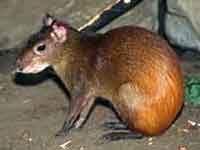
The agouti is a medium sized rodent, and is bigger than the largest guinea pig, with longer, thinner legs. They have a largish head and a plump body. Their short, thick hair lies flat and shiny. The ears are nearly hairless and of medium small size. Agoutis are ground dwellers and built for running with speed. They walk, trot or gallop on their toes, and can jump up more than six feet from a standing position.
In the wild pairs only come together to breed. At high densities, the range of the male and female may overlap, giving the appearance of living in pairs. Unlike most solitary rodents, however, captive males are quite tolerant and friendly toward the young.
Agoutis are strictly herbivorous and live mostly on fallen fruits and nuts. They are attracted to the sound of ripe fruits hitting the ground. When food is plentiful they bury excess nuts and fruits for use when food is scarce. Agoutis are normally active during the day, but become nocturnal if disturbed or molested.
Agoutis are preyed upon by larger predators, coatis, cats, dogs and humans.
Baird's Tapir - - - Tapirus bairdii

These massive animals are also known as "mountain cows" in Belize are found in the dense tropical jungles of Central America up to an altitude of 10,700 ft in. They can grow up to 800 pounds. The word "tapir" comes from a Brazilian Indian word meaning "thick" which refers to the animals hide. These animals are in the same family as horses and rhinos. This is the national animal of Belize.
The thick hide is covered with a short, bristly-haired, dark brown coat. Young animals have a reddish-brown coat brightly marked with white streaks and spots. At higher elevations, animals grow thicker coats as protection from the cold. The throat and cheeks are a light grayish-yellow, and there is usually a dark spot situated below and behind the eye. The edges of the rounded ears are white. The most noticeable feature of the tapir is its prehensile nose, which looks and functions like a shortened version of an elephant's trunk. Baird's tapir is the largest and heaviest of the New World tapir species, with a barrel-shaped body and stocky legs. There is no crest on the neck.
Baird's tapir can be either diurnal or nocturnal, although most activity occurs during the night. They are very agile and can negotiate steep slopes with ease. The tell-tale sign of Baird's tapir are repeatedly used paths through the jungle, which the tapirs mark regularly. Tapirs usually stay close to water, and on hot days have been observed submerged with only their heads above the surface. They communicate with shrill whistles.
This Solitary animal feeds on Plant matter, including fallen fruit. Its Main Predators are Mountain lion, jaguar, humans
Black Howler Monkey - - - Alouatta pigra
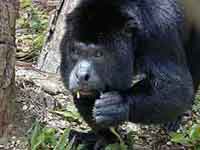
The chances are good that you will hear a black howler monkey before you see one. These animals are well known for their distinct noises that they use to protect their territory from other troops. Black howlers are known in Belize as "baboon" is the largest monkey in Belize and one of the largest in the Americas. They are typically found in lowland forest where they feed on fruit, leaves, and flowers.
Belize has a healthy population of these loudest of primates. Black howler monkeys live in troops of between 4 and 8 members. Each troop has its own territory in which it feeds and lives. The size of the territory depends on the size of the troop, ranging from 3 to 25 acres. Baboons defend this territory from other troops through the use of their voices. The howling is one of the loudest animal sounds in the tropical forest of Belize.
Howler monkeys are vegetarians, feeding on flowers, fruits and leaves. Within Belize, a special "Community Baboon Sanctuary" conservation organization has protected land along the Belize River for the Howler, ensuring that their food trees are not destroyed to make way for pasture.
Collared Peccary - - - Peccary angulatus

The Collared Peccary inhabits tropical rainforests In South and Central America. They have large heads and long snouts with thick coats of dark-gray, bristly hair and band of white hair (collar) around the neck. A mane of long, stiff hairs runs down the back from head to rump, where scent gland is located. The adult male Collared Peccary is 46 to 60 inches in length and is usually 20 to 24 inches in height. The adult male weighs between 40 and 60 pounds.
Peccaries usually travel in a band from 6 to 12 although as many as 50 have been seen together. They are most active during early morning and evening when it is cooler. Unlike many other animals, Peccaries are unable to evaporate moisture through panting to prevent overheating. During the fierce heat of midday, they bed down in the shade and forage where it's cooler.
Collared Peccaries are primarily herbivorous, and have complex stomachs for digesting coarsely-chewed food. In the northern range, Collared Peccaries eat more herbivorous foods, such as roots, bulbs, beans, nuts, berries, grass and cacti. Despite all this supplementary diet, the main dietary components of this species are agaves and prickly pears.
Mexican Hairy Porcupine
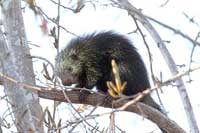
Ranging from Southern Mexico to Western Panama the Mexican Hairy Porcupine is mostly a dark brown to black rodent with fur that covers most of the long spines on the body. The head is marked by yellowish spines that are visible through the fur, and by light-colored fur tufts near each ear and has a prehensile tail that becomes naked away from the body. Adults range from 21.5 to 31.5 in (55–80 cm) with the tail accounting about 1/3 to 2/5 of that total length, and weigh about 5.5 lb (1.5-2.5 kg).
Mexican Hairy Porcupines are nocturnal and arboreal animals that spend their days sleeping in vegetation among branches, in tree hollows, or in bamboo undergrowth, although some evidence suggests they might also utilize dens and caves. A usually solitary animal, males will fight with other males, but will tolerate females.
This porcupine favors high-elevation forests, but occasionally found in lowland habitats. We, in fact, have one that roams our sea side property in Consejo, Belize almost nightly. Our dog, a natural rodent hunter, learned quickly to leave this animal alone! Their primarily defensive weapon is The quill, specialized hairs that are extremely sharp and detach easily. once embedded in flesh, the quill will continue to go inward, propelled by microscopic fibers that are pointed away from the tip. The quills themselves can reach up to three inches in length, and make for a painful removal due to their microscopically barbed nature. A common misconception is that a porcupine can 'fire' a quill at you; this is not true, contact must be made for the quill to stick, and the porcupine has no mechanism for flinging a quill.
Paca - Gibnut
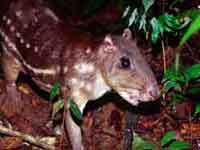
Found throughout Central America, the paca has coarse fur that is dark brown to black on the upper body and white or yellowish on the underbelly. It usually has three to five rows of white spots along its sides. It has thick strong legs, with four digits in the forefeet and five in the hind feet. The tail is short and hairless. An adult paca weighs between 12 and 25 lbs, which makes it the second-largest rodent.
The Paca, known as the gibnut in Belize, is a nocturnal rodent. Inhabiting the forest floor, this solitary animal feeds on fallen fruit, leaves and some tubers dug from the ground. The gibnut is most often found near water and are found throughout many habitats of Belize, from river valleys to swamps to dense tropical forest. They dig simple burrows about 6 ft below the surface. Pacas are good swimmers and usually head for the water to escape danger.
Their diet includes leaves, stems, roots, seeds, and fruit, especially avocados, mangos and zapotes.
Red Brocket Deer - - - Mazama americana
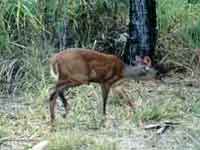
The Red Brocket Deer is distributed from Mexico through Central and South America as far as northern Argentina.
It is found in thick forest where there is dense undergrowth particularly swampy areas and close to rivers. They are well adapted to forest life with short front legs and antlers, found only on the males, simple and short enough to slip through the vegetation. They are common in the Mountain Pine Ridge area.
The body and legs are a rich chestnut brown while the head and neck are grey-brown. The face is plain. The young are red with white spots for the first few months.
White-tailed deer - - - Odocoileus virginianus
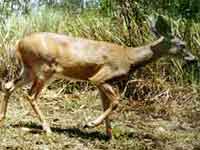
The White Tailed Deer, is a medium-sized deer found throughout most of the continental United States, southern Canada, Mexico, Central America and northern portions of South America as far south as Peru. White-tailed deer are generalists and can adapt to a wide variety of habitats. Although most often thought of as forest animals depending on relatively small openings and edges, white-tailed deer can equally adapt themselves to life in more open savannas.
